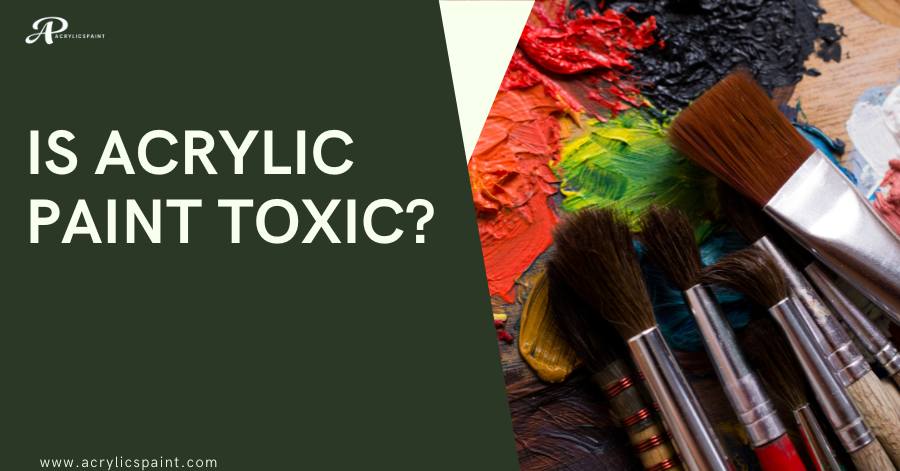Is Acrylic Paint Toxic? Acrylic paint is a fast-drying paint made of pigment suspended in acrylic polymer emulsion. Unlike oil paints, which use oils as a binder, they use water as a solvent, making them water-based and easy to clean up. Whether acrylic paint is toxic is a valid concern for artists, especially those who work with it regularly. Like many substances, it contains chemicals that can be harmful if not used properly. However, it’s essential to distinguish between the toxicity of acrylic paint and its potential risks.
In this blog guide, we will answer your question and suggest safe alternatives so you can paint without worry.
Is acrylic paint toxic? What You Need to Know for Safe Use
Is Acrylic Paint Toxic? Acrylic paint toxicity is a significant concern when it comes to accidental ingestion. While acrylic paint is not meant to be consumed, there are instances where children or pets may mistakenly ingest it. This can happen if the paint is left within reach or mistaken for food or a drink.
If you swallow acrylic paint, you may feel sick, throw up, or have other stomach problems. Swallowing acrylic paint can make you feel sick to your stomach, vomit, or experience other stomach issues. How sick you get from eating paint depends on how much you eat and how sensitive you are to the chemicals.
Sometimes, swallowing acrylic paint can lead to more severe health issues, such as difficulty breathing or allergic reactions. Sometimes, swallowing acrylic paint can cause even worse health problems like trouble breathing or allergic reactions. It is essential to keep acrylic paint and other potentially toxic substances out of reach of children and pets to prevent accidental ingestion.
If someone ingests acrylic paint, it is essential to seek medical attention immediately to ensure proper treatment and avoid further complications. Acrylic paints may contain pigments such as cadmium, which can be toxic if ingested or inhaled in large quantities over an extended period. Please note that some acrylic binders contain heavy metals and other chemicals that can pose health risks if improperly handled.
Cadmium Paint
Cadmium is a heavy metal often used as a paint pigment to achieve vibrant colors. However, cadmium compounds can be highly toxic, particularly if ingested or inhaled in dust. Artists should be cautious when using cadmium paints. They should wear gloves and a mask to prevent contact and inhalation.
Chemicals in Paint
Paints may contain various chemicals, including volatile organic compounds (VOCs), formaldehyde, and ammonia. Chemicals can be released into the air, leading to air pollution and health issues like irritation, headaches, and dizziness. Proper ventilation is essential to minimize exposure to these harmful substances when working with paint.
Are Oil-Based Paints Toxic?
Compared with oil-based paints, they are traditionally made using linseed or other oils as binders. While oil paints are generally not considered toxic in the same way as some acrylic paints, they do pose their own set of risks. The solvents used with oil paint create toxins, such as turpentine or mineral spirits, that can be harmful if inhaled or absorbed through the skin.
Is Acrylic Paint Toxic if Ingested?
Ingesting acrylic medium, especially in large quantities, can lead to various health issues. While acrylic colors are not formulated for consumption, accidental ingestion can occur, particularly among children or pets. When ingested, acrylic paint can cause discomfort, nausea, vomiting, and, in severe cases, may lead to poisoning. Therefore, it’s essential to store acrylic paints safely out of reach of children and pets and to seek medical attention immediately if ingestion occurs.
What Happens if You Eat Paint?
The consequences of eating paint depend on the type of paint ingested and the amount consumed. Ingesting small amounts of non-toxic paint may result in mild symptoms such as stomach upset or irritation. Consuming toxic paints containing heavy metals such as cadmium can lead to severe health issues. These may include poisoning, damage to organs, and long-lasting health problems. Prompt medical attention is crucial if paint ingestion occurs to prevent further harm and provide appropriate treatment.
Non-Toxic Options
Fortunately, many manufacturers offer water-based acrylic paints labeled as non-toxic. These paints are formulated to be safer for artists and the environment, containing fewer harmful chemicals. Non-toxic acrylic paints are an excellent choice for artists’ safety and environment.
Washable and Easy Cleanup
Water-based acrylic paints are known for easy cleanup, making them ideal for use in educational settings and with young artists. Their easy cleanup with soap and water reduces exposure to harmful chemicals, minimizing risks. At the same time, heavy-body acrylic paints are characterized by their thick consistency and high pigment concentration.
However, heavy-body acrylic paint also presents challenges in handling and cleaning. Artists should be mindful of potential exposure to paint chemicals during mixing, application, and cleanup processes. Proper ventilation, PPE usage, and adherence to safety protocols are essential when working with heavy-body acrylic paints to reduce the risk of inhalation or skin contact with harmful substances.
Non-Toxic Paints
In recent years, the demand for non-toxic paints has grown as artists seek safer alternatives without compromising quality or performance. Paint manufacturers like Liquitex and Utrecht offer non-toxic paints formulated with natural and synthetic ingredients free from harmful chemicals, offering artists peace of mind and reducing environmental impact. Choosing non-toxic paints protects artists’ health and promotes a safer and more sustainable artistic practice.
Conclusion
In conclusion, Is acrylic paint toxic? while acrylic paint does contain chemicals that can be toxic if mishandled or ingested, it can be used safely with proper precautions. Opting for water-based, non-toxic acrylic paints and practicing good safety habits, such as avoiding ingestion and ensuring adequate ventilation, can minimize acrylic paint toxicity risks.
To stay safe while creating art, use non-toxic paints, follow safety rules, and be careful with materials. Protecting your health and well-being while enjoying the creative process is essential. Remember, art should be a source of joy and inspiration, not a cause for concern about toxicity.











